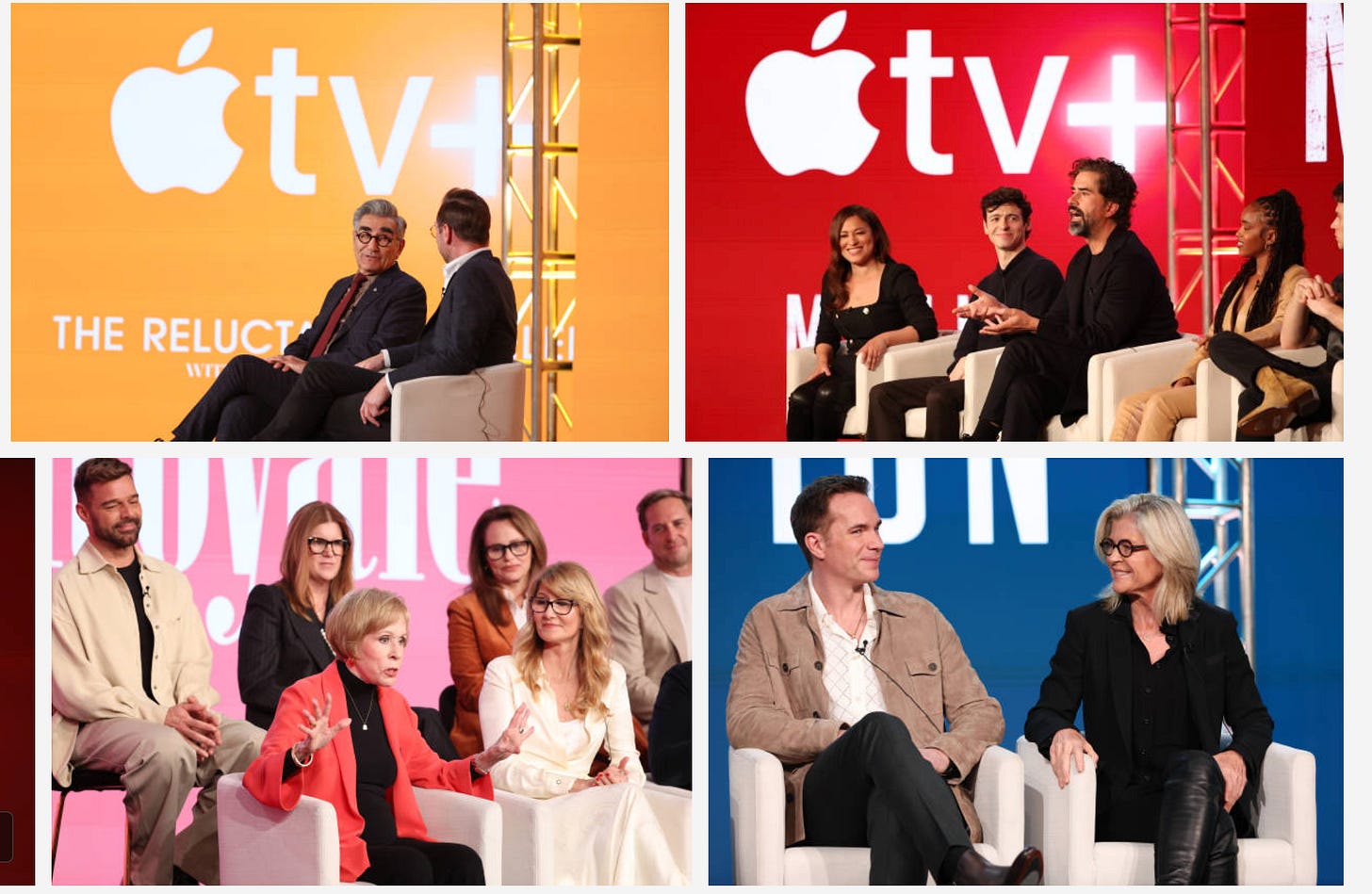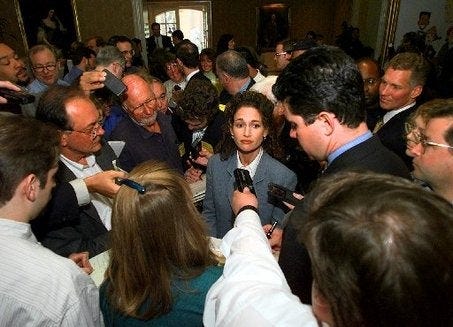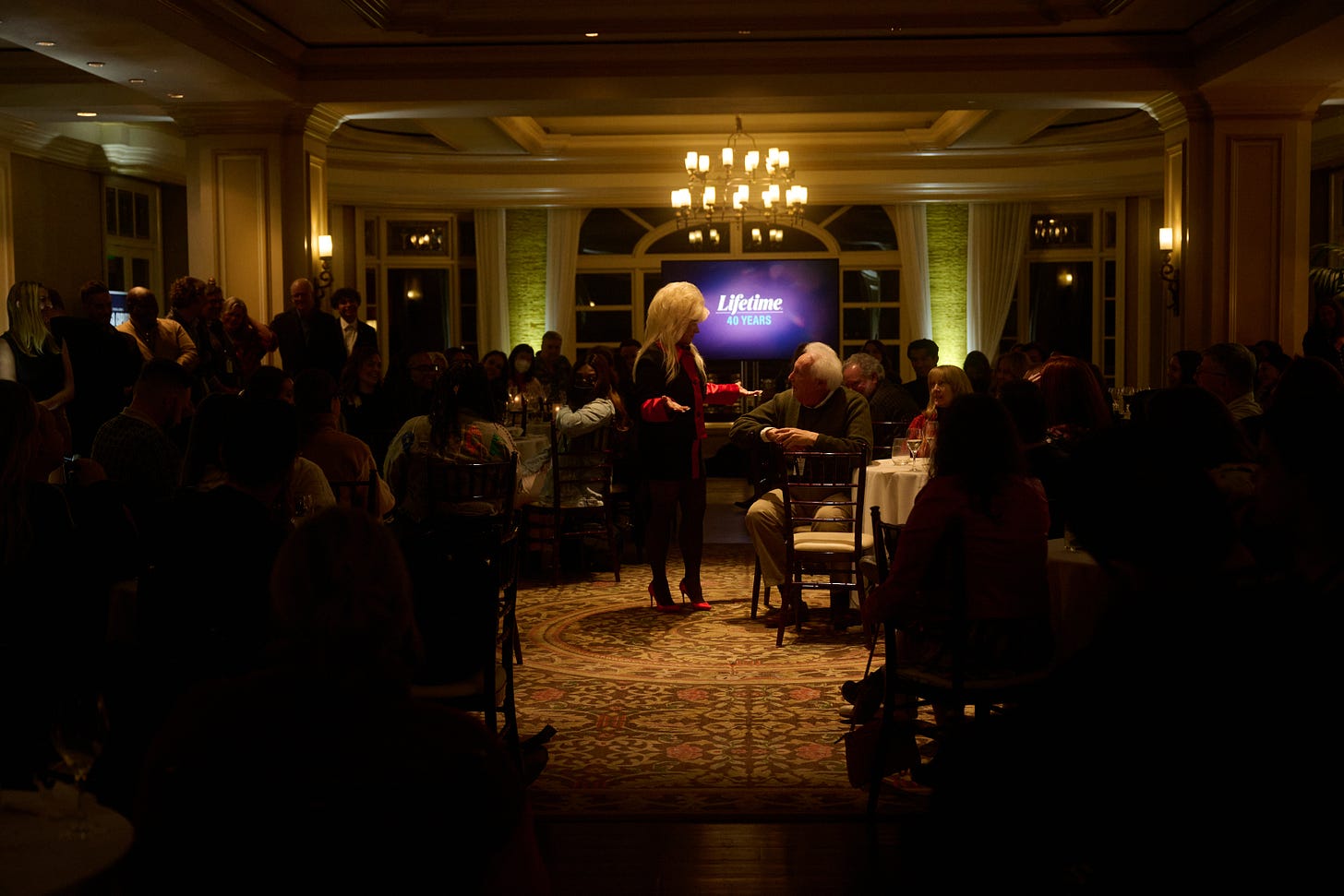Panel-to-Panel: An Introduction to the Television Critics Association Press Tour
The first of several reports on the state of the television industry from Pasadena
Week-to-Week—well, in this case Panel-to-Panel—is the (mostly) weekly newsletter of Episodic Medium. To receive future newsletters for free, and get updates on the shows we’re covering weekly for paid subscribers (you can find our winter schedule here), click below.
On Monday evening in Pasadena, Lifetime celebrated its 40th anniversary with a live reading from Theresa Caputo, formerly known as the Long Island Medium at her previous home TLC. After dinner and drinks were served, Caputo worked her way through the gathered crowd and—per her explanation—channeled the spirits of dead loved ones.
That crowd wasn’t her normal audience, though. Used to performing for large groups who come actively hoping one of their “departed” reaches out to them, Caputo was instead working a room where at least half of those in attendance were journalists gathered for the Television Critics Association (TCA) press tour. While she’s likely used to working with some amount of skepticism, I couldn’t help but wonder if she found the experience unique as she searched the crowd for the non-journalists Lifetime had invited and who seemed (too?) eager to reveal their past tragedies.
Of course, it’s possible that Caputo wasn’t briefed on the specifics of her audience (she acknowledged that we were “among colleagues,” but she might have just thought it was Lifetime employees). But even if she had been, the specifics of the TCA Press Tour are always hard for outsiders to grasp, which makes it more impressive when attendees have a handle on them: in the last panel of the day for Apple TV+’s forthcoming Land of Women, Eva Longoria quipped “You can’t clap, but I’ll clap” after an answer from creator Ramón Campos, showcasing her past experience with a room where celebrities are onstage but none of those in attendance applaud (no, not even for Carol Burnett’s appearance earlier in the day). It’s just a fundamentally weird space, even if there’s not a TV medium fishing for trauma among those present.
This is my fifth-ish time attending Press Tour, and my first as a representative of Episodic Medium and a formal member of the TCA.1 I want to bring insights gleaned from the two weeks of panels that are set through February 15 to your inboxes every few days, but this first installment of “Panel-to-Panel” needs to reckon with some of those idiosyncrasies that define the Press Tour Experience at a time when the event is in a state of flux following its COVID hiatus.

The basic facts remain the same: the TCA Press Tour is a series of press conferences, meals, and cocktail parties hosted by stakeholders in the television industry, where assembled journalists ask questions of the producers, stars, and executives behind current and upcoming shows. Of course, those stakeholders are changing in the streaming era: Monday’s first day was dominated by panels from Apple TV+, while consolidation has Disney overseeing three days of programming later this week swinging from National Geographic documentaries to FX dramas. On paper, though, the panels are mostly the same across the board: a trailer shows in the ballroom, the panelists are ushered onstage in the dark, and when the lights come up journalists raise their hands and mic runners rush to them to get the discussion started.
That being said, while each panel takes the same form, there are two key variables that complicate any effort to generalize about the value of this particular ritual. The first is that the journalists present come from a wide variety of backgrounds. Some are trade reporters whose focus is news, meaning that panels without new announcements or information about future programs don’t necessarily offer anything to bring to their audiences. Others, meanwhile, write for publications focused on celebrity, meaning their goals most often involve talking to stars as opposed to producers. Critics like myself, meanwhile, are most interested in dynamics of industry and storytelling, while others might be more hyper-focused on particular genres.
The result is a really wide range of questions being asked in the ballroom, which may or may not be “helpful” to the work of a given journalist—as someone who asks more academic questions, for instance, I know that some in the room are probably getting nothing from the answers, even if I’m gleaning insights to bring back to both this newsletter and my teaching and research.
One of the ways this has historically been addressed was with the “scrum,” a process whereby the end of a panel brings a stampede of critics onto the stage to ask additional questions of panelists. In addition to allowing people to ask questions that they thought might be more niche than the ones they’d ask as part of the larger panel, it also gave journalists hoping for exclusive quotes and details about future storylines the opportunity to get those without the rest of the room listening in.

But in our COVID reality, the scrums were discontinued, and it’s really changed the dynamics of the ballroom. On the plus side, there’s now a greater diversity of questions being asked in a given panel—historically, many journalists would “save it for the scrum,” and it would result in a dearth of questions in the panels themselves. This infamously led to the “Jay Bobbin Rule,” in which the syndicated columnist would fill the vacuum with questions to the point where it clearly signaled a show wasn’t generating the buzz needed to survive. As someone who has mostly been here as “research” in the past, I’ve often found myself asking multiple questions in slow panels (although I don’t think I ever reached seven, considered the death knell from Jay). But at least through the first two days of presentations by Apple and a collection of cable networks, the mic runners have been plenty busy, with the usual suspects joined by a collection of journalists who may have saved questions for the scrum before.
However, the absence of scrums has undoubtedly narrowed the overall value of an average Press Tour session. From a research perspective, I always appreciated the opportunity to follow up on questions from the panel to get more insight. I still regularly use anecdotes I gained from those casual conversations in my classroom and my research, and for journalists who aren’t with big outlets and might struggle to get access to talent through publicists, scrums were often the only way they were going to get that kind of opportunity. I have absolutely no desire to be in a crowd of 25 journalists crowding around a big star shoving a recorder into a mass of bodies to get a soundbyte (not that I was before) given the COVID risks, but I’d have loved the chance to chat more with Loot co-creators Alan Yang and Matt Hubbard about the balance of workplace sitcom and serialized dramedy following their panel that kicked things off Monday, and that absence has been notable even as someone who isn’t hunting for “scoops.”
The second variable, though, has less to do with the audience and more to do with the shows being paneled. Apple TV+’s day was certainly star-studded, with Carol Burnett, Michael Douglas, Laura Dern, and other big stars alongside the show’s creators. However, Apple TV+ is a massive operation, with huge marketing budgets that don’t necessarily need additional attention from assembled critics (you may have seen the above trailer without my prompting, for example). While big stars naturally generate better headlines, they’re not dramatically different headlines than what would have been written about the show in the abstract—spontaneous “in the room” moments like Maya Rudolph arriving fashionably late to the Loot panel due to the California rain storm or Jonathan Banks interrupting Eugene Levy’s Reluctant Traveler panel to troll an old friend are thrilling, but fun anecdotes don’t really create meaningful insights into the shows or the larger industry (if that’s what you’re here for, per the above).
Compare that to Tuesday morning, though, when BET+ carved out a half-hour of time for Diarra from Detroit, a comedy mystery series from star/creator Diarra Kilpatrick. This was a show that wasn’t on my radar, and likely wasn’t on the radar for most of the mostly-white critics in the room. I know BET+ exists, but the service—like the cable channel it’s connected to—has settled into the (vital and lucrative) niche of African-American-focused programming, and has lacked a breakout success to bring their shows into more general discourse around the industry. Executive producer Kenya Barris has had projects set up at nearly every streaming service, and while he insisted when I asked that diverse shows are now prominent across all platforms, we’re seeing a clear retraction of some of streaming’s initial push into diversity that makes platforms like BET+ who make it part of their very identity increasingly important to helping voices like Kilpatrick find their place in the industry. The screener I watched was enjoyable (a dark comedy true crime riff rooted in Detroit albeit by way of its New Jersey filming location), the panel offered some good additional insights into the series, and I’m sure there are people in the room who wouldn’t have covered it who are now likely to give it a chance.
While Tuesday wasn’t quite as star-studded as Monday, the organization of the day created more opportunities to enrich journalists’ perspective on the shows being highlighted in this way. Hallmark Channel, who has a long history of hosting lavish parties to a sometimes cold reception to the actual content itself, are comparatively thriving in a moment where their new approach to original series (the time travel drama The Way Home) and diversification of their movie lineup (a take on Sense & Sensibility under their Mahogany banner) give them something newsworthy with a larger swath of the assembled journalists. And they followed it up with a “Regency Era” lunch with a string quartet and talent seated at the tables, which let me and a group of other reporters chat with Hallmark regular Luke MacFarlane about his work for the cable channel, the surprise renewal of Apple TV+’s Platonic, and how the show’s first season was the reason he had to back out of being one of Barbie’s Kens. I also got an opportunity to follow up with The Way Home co-creator Alexandra Clarke after realizing her show is actually set in the Canadian province of New Brunswick, having noted my own roots in neighboring Nova Scotia during my question to the panel.
The afternoon’s sessions from AMC were similarly followed by a cocktail party, which gave journalists a chance to follow up on the earlier panels. While I chose not to dig deeper with Chief Content Officer of the Walking Dead Universe Scott Gimple about his claim during the panel for the Rick and Michonne miniseries that story is the only guide for the franchise when “content” is literally in his title (seemed a bit futile), I did get the chance to follow up with Parish co-creators Eduardo Javier Canto and Ryan Maldonado about their decision to set their Giancarlo Esposito-led remake of British series The Driver in New Orleans. Those kinds of opportunities are something I’d struggle to get through a publicist coming from outside a major publication, and it’s this type of opportunity that Press Tour is designed to create for members from outside of L.A., or members who write for smaller publications or cobble together a living based on freelance opportunities. But it’s also one that doesn’t happen when streamers like Apple bypass lunches or cocktail parties as part of their schedules.
There’s a fascinating push-and-pull dynamic to Press Tour: networks are spending huge amounts of money to host the panels and related events, hoping for a return on their investment in the form of articles and tweets about their shows. Journalists, meanwhile, are either sent by their outlets or self-funding trips to Los Angeles in the hopes of getting distinct opportunities to dig deeper into their respective beats. But in the absence of additional opportunities for followup or executive sessions with the chance to talk to the gatekeepers making decisions (Apple has never done one), I’m not sure that an average freelance critic would be able to justify the cost to be in person for press conferences, and I’m also not convinced that the resulting coverage is giving networks the value they’re looking for.
After the world didn’t stop turning when Press Tour went on its COVID hiatus, replaced with virtual press events, the event entered an existential moment. Personally, as hard as it is to explain to someone, I remain convinced that the distinct dynamics of “the ballroom” create a vital opportunity to understand the contemporary television industry, and virtual events will never create the same type of space. However, the event’s usefulness in an era of increased instability in journalism is something that needs to be considered, and something that’s less of a concern for me as someone there for an open-ended “research” and this mercurial newsletter as opposed to needing to convince editors to pay me for my coverage.
In the meantime, I’ll simply do my best to ask questions that speak to the state of television today, and bring those insights into my work both inside and outside of the classroom.
Episodic Observations
I’ll share more insights gleaned from questions during panels when the shows in question start to debut, especially in the case of Apple TV+, but The New Look is their next series to debut, and I actually watched all ten episodes ahead of that panel. And while creator Todd A. Kessler challenged my suggestion that it’s really two different shows (agree to disagree), I didn’t mean it in a bad way, and it’s a striking and compelling set of parallel dramas about Christian Dior and Coco Chanel set against the same backdrop of post-Nazi occupation Paris with strong performances all around.
Lunches or cocktail parties are often where you’re able to get a sense of “stars” as “real people” (Macfarlane was incredibly generous with our group, even before he learned I was Canadian and we talked about how his sister almost went to my alma mater), but sometimes panels can do the same. Ben Mendelsohn jumped offstage after the New Look panel to answer a reporter’s question after his attempt was cut off earlier by another reporter, while Laura Dern both helped Carol Burnett onto the stage and worked hard in her answers to ensure that those onstage for Palm Royale who hadn’t received questions yet had a chance to weigh in and be heard.
I’m generally never happy when a panel for a show has stars without directors or writers involved, but I can’t pretend Michael Douglas couldn’t command the room promoting his upcoming Franklin, to the point where he was answering questions about Benjamin Franklin’s life in the first person.
If there are any questions about Press Tour, or about specific panels that you may have seen reports of across social media, let me know in the comments. I’ll be checking in periodically during the tour with updates, the next of which will likely arrive following the end of Disney’s three days of panels starting tomorrow.
Thanks to everyone who’s subscribed and helped make this happen—it’s a real full circle moment in my time as a television critic, and only possible thanks to what Episodic Medium has become, and none of that happens without your support for myself and our contributors. Oh, and it’s “fifth-ish” because I was only here for a day a year ago on my way to Australia.



I am thrilled, THRILLED, about this series. I think I got more insight about TCA from this post than I have in years and years of tweets and articles from longtime regulars (no disrespect, but their posts about the event itself were sidelights to the stories they came to get for their beats, understandably), and I came away from reading this thinking about how vital it is to understand the event and its participants on a structural and role-based level.
Oh yay! I'm so glad you're there and giving us updates. I've always been fascinated by TCA Press Tour and this was such a great insight. I remember back when Twitter was healthy-ish that my feed would be flooded with anecdotes from the TV critics & reporters I follow who were there. But the last few years (and I know COVID had a lot to do with it) I sometimes don't even know the event is happening until it has a news story break (this year too). I miss getting to see so many reactions but I'm glad to have access via you to what's going on this year.